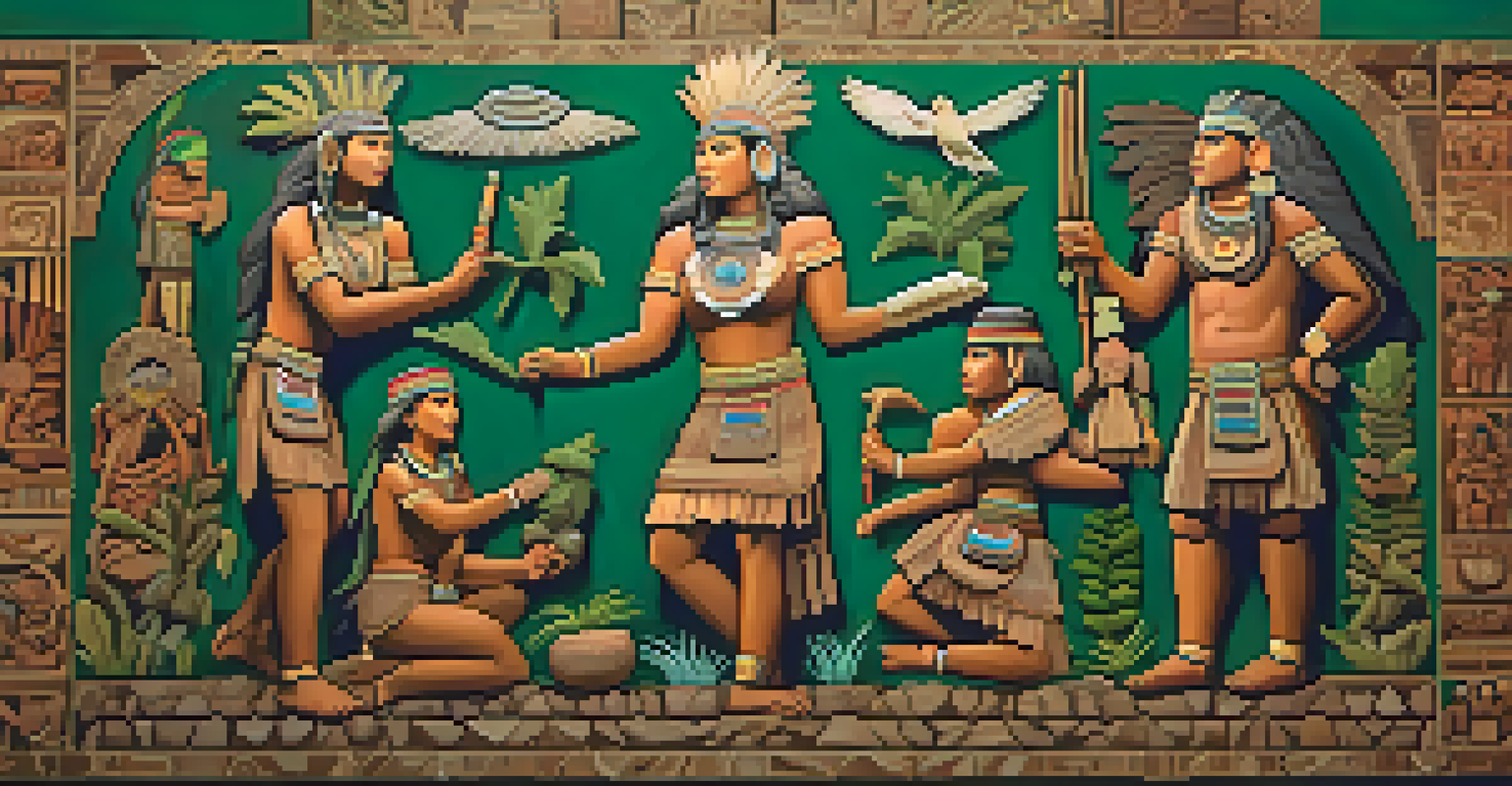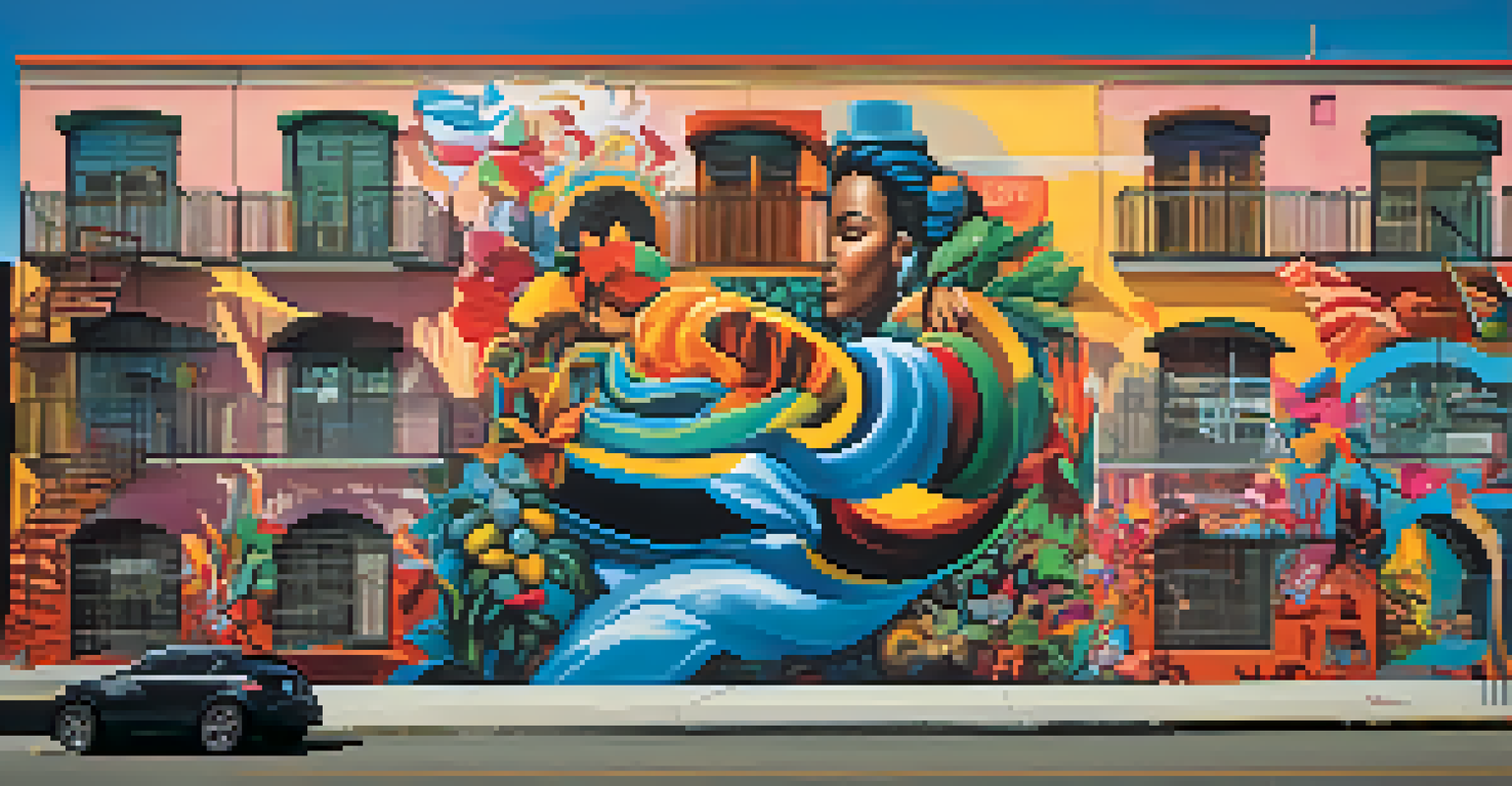The Vibrant Colors of Mexican Muralism and Social Commentary

The Origins of Mexican Muralism and Its Cultural Significance
Mexican muralism emerged in the early 20th century, during a time of social upheaval after the Mexican Revolution. Artists like Diego Rivera, José Clemente Orozco, and David Alfaro Siqueiros sought to reflect the struggles and aspirations of the Mexican people. Their works were not just art; they were powerful tools of social commentary, aiming to educate and inspire the public on issues of class, identity, and history.
Art is not a mirror to reflect the world, but a hammer with which to shape it.
These murals often adorned public buildings, making art accessible to everyone, not just the elite. The vibrant colors and grand scale of these works captivated viewers, drawing them into a visual narrative of Mexico's past and future. This movement emphasized the importance of community and collective identity, marrying artistic expression with political activism.
As we explore the vivid hues and themes in Mexican muralism, we see how these artists used their talents to challenge societal norms and advocate for change. Their murals become a canvas for storytelling, reflecting the heart and soul of a nation grappling with its identity.
The Role of Color in Mexican Muralism
Color plays a crucial role in Mexican muralism, with each hue carrying its own meaning and emotion. Bright reds might represent revolution and passion, while deep blues can evoke tranquility and trust. Artists used these colors deliberately to communicate their messages, ensuring that viewers felt the weight of the social issues being portrayed.

For instance, Rivera’s murals often feature strong, vivid colors that symbolize the power and resilience of the working class. The use of color not only captures attention but also stirs emotions, making the viewer feel connected to the subjects depicted. This approach transforms the murals into a dialogue between the artwork and its audience, inviting them to reflect on their own experiences.
Muralism as Social Commentary
Mexican muralism serves as a powerful tool for social commentary, addressing issues of class, identity, and history through vibrant public art.
The interplay of color and form in these murals creates a dynamic visual experience, encouraging viewers to engage with the stories being told. As we delve into the palette of Mexican muralism, we uncover layers of meaning that enhance our understanding of the social commentary embedded within each piece.
Key Themes in Mexican Muralism: Unity and Struggle
A prominent theme in Mexican muralism is the idea of unity among the people, particularly in the face of struggle. Many murals depict scenes of workers and peasants coming together, symbolizing strength in solidarity. This theme resonates deeply within the context of Mexico’s history, where communal efforts were vital in achieving social change.
The function of art is to disturb. It is only the disturbance that can lead to the new.
Artists often illustrated the working class as heroic figures, celebrating their labor and contributions to society. For example, Orozco's works frequently highlight the plight of the oppressed, offering a poignant reminder of the ongoing fight for justice and equality. These narratives serve as both a reflection of the past and a call to action for the future.
Through their art, these muralists foster a sense of hope and resilience, urging viewers to recognize their power in shaping society. The themes of unity and struggle continue to inspire generations, reminding us that the fight for social justice is a collective journey.
Influence of Indigenous Culture on Muralism
Indigenous culture plays a significant role in Mexican muralism, with many artists drawing inspiration from pre-Columbian history and traditions. This connection to indigenous roots is evident in the motifs, symbols, and narratives portrayed in the murals. By integrating these elements, artists not only honor their heritage but also critique the colonial narratives that have historically marginalized indigenous voices.
Murals often feature figures and stories from indigenous mythology, celebrating the rich tapestry of Mexico's cultural identity. This reclamation of indigenous heritage serves as a powerful statement against cultural erasure, emphasizing the importance of acknowledging and preserving one's roots. It also fosters a sense of pride among viewers, reinforcing the idea that their history is a vital part of their present.
Unity and Struggle Themes
Key themes in muralism emphasize unity and collective struggle, highlighting the strength of the working class and the fight for social justice.
The blending of indigenous themes with contemporary social issues creates a unique dialogue within the murals, bridging the past and the present. Through this lens, we see how Mexican muralism acts as a vehicle for cultural revival and social commentary, inviting viewers to reflect on the complexities of their identity.
The Impact of Political Context on Mural Themes
The political landscape of Mexico has profoundly influenced the themes and messages conveyed in muralism. Following the Mexican Revolution, artists felt an urgent need to address the social injustices and inequalities that persisted in society. Murals became a powerful medium for political expression, allowing artists to voice their critiques of government and promote revolutionary ideals.
For instance, Rivera’s murals often depicted the struggles of the working class against oppressive regimes, portraying the fight for labor rights and social equity. These powerful images served to galvanize public sentiment and inspire activism, showcasing art as a catalyst for change. The connection between politics and art not only deepened the impact of the murals but also established them as a significant part of Mexico's political discourse.
As we delve into the political context surrounding Mexican muralism, we recognize the courage of these artists in confronting societal issues through their work. Their murals remain a testament to the power of art as a tool for social change, encouraging ongoing dialogue about justice, equality, and the role of the individual in shaping society.
Women in Mexican Muralism: Their Stories and Contributions
While many prominent figures in Mexican muralism are male, women artists have also made significant contributions to this movement. Figures like Frida Kahlo and Rosa Rolando used their art to address issues of gender, identity, and personal struggle. Their work reflects a unique perspective, often intertwining personal narratives with broader social commentary.
Kahlo, in particular, is known for her introspective self-portraits that explore themes of pain, identity, and the female experience. Though not a traditional muralist, her influence on the art world and her exploration of women's issues resonate deeply within the muralist movement. Similarly, other female artists have used muralism as a platform to amplify women's voices and experiences, challenging societal norms.
Indigenous Influence on Art
The integration of indigenous culture in murals honors heritage and critiques colonial narratives, fostering pride and cultural revival.
By examining the role of women in Mexican muralism, we gain a more comprehensive understanding of the movement. Their stories and contributions enrich the narrative of muralism, highlighting the importance of inclusivity in the artistic dialogue surrounding social issues.
Modern Interpretations and Legacy of Mexican Muralism
Today, the legacy of Mexican muralism continues to thrive, inspiring a new generation of artists worldwide. Contemporary muralists draw upon the vibrant colors and social themes established by their predecessors, adapting them to reflect current social issues. This evolution of muralism showcases its relevance, proving that art can be a powerful vehicle for change across different contexts and cultures.
Modern artists often incorporate elements of street art and graffiti, creating a fusion of styles that speaks to urban communities. The accessibility of murals allows for a broader audience to engage with important social commentary, fostering a sense of community and dialogue. This transformation highlights the adaptability of muralism, as it evolves to meet the needs of contemporary society.

As we look to the future, the principles of Mexican muralism—community engagement, social justice, and cultural pride—remain as important as ever. This enduring legacy serves as a reminder of the power of art to challenge, inspire, and unite people in their shared struggles and aspirations.